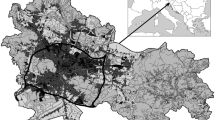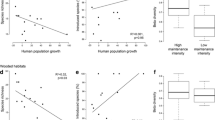Abstract
The effect of urbanization on species distribution has been extensively documented, but a main challenge in urban ecology is to better understand the factors causing different distributions among species in response to urbanization. Hence, this paper aims to compare the effects of urbanization on woodland plant assemblages in two cities and to describe species responses by using several indicators. The study was carried out in the cities of Angers and Rennes (North-Western France) where 11 isolated woodlands were surveyed along an urban–rural gradient in each city. Abundance data of spontaneous species were collected from 220 quadrats. The effect of land cover (within a 500 m buffer around each woodland) on species assemblages was investigated by Canonical Correspondence Analysis. Buildings and pavement areas were the most significant predictors of species composition, and the effect of location in Angers or Rennes appeared on the second axis. More than 60% of the most frequent plant species were indicator of urban or rural location and their preferences were similar in the two cities. These lists of urban and rural indicator species were compared with Ellenberg’s indicator values and two other indicators specific to forest environment. The species which grow preferentially in urban woodlands are species which are already known to be associated with recent forests rather than ancient forests; with hedgerows rather than woodlands. The opposite pattern was observed concerning rural species. Moreover, urban indicator species have higher optima for soil pH and soil nitrogen content than rural indicator species. Different characteristics and history of forest habitat—continuity of the forest land cover, linearity of the habitat, change in adjacent land cover and land use—could select the same species, and the responses of the latter might involve different preferences concerning soil alkalinity and nutrient status.



Similar content being viewed by others
References
Bastin L, Thomas CD (1999) The distribution of plant species in urban vegetation fragments. Landscape Ecol 14:493–507. doi:10.1023/A:1008036207944
Benvenuti S (2004) Weed dynamics in the Mediterranean urban ecosystem: ecology, biodiversity and management. Weed Res 44:341–354. doi:10.1111/j.1365-3180.2004.00410.x
Blair R (2004) The effects of urban sprawl on birds at multiple levels of biological organization. Ecol Soc 9(5), art 2 available online from http://www.ecologyandsociety.org/vol9/iss5/art2
Braun-Blanquet J (1965) Plant sociology, the study of plant communities. Hafner Publishing Company, New York
Brunet J, Von Oheimb G (1998) Migration of vascular plants to secondary woodlands in southern Sweden. J Ecol 86:429–438. doi:10.1046/j.1365-2745.1998.00269.x
Clergeau P, Jokimäki J, Savard J-PL (2001) Are urban bird communities influenced by the bird diversity of adjacent landscapes? J Appl Ecol 38:1122–1134. doi:10.1046/j.1365-2664.2001.00666.x
Czech B, Krausman PR, Devers PK (2000) Economic associations among causes of species endangerment in the United States. Bioscience 50:593–601. doi:10.1641/0006-3568(2000)050[0593:EAACOS]2.0.CO;2
Daniel H, Lecamp E (2004) Distribution of three indigenous fern species along a rural-urban gradient in the city of Angers, France. Urban For Urban Green 3:19–27. doi:10.1016/j.ufug.2004.04.001
Dufrêne M, Legendre P (1997) Species assemblages and indicator species: the need for a flexible asymmetrical approach. Ecol Monogr 67:345–366
Ellenberg H, Weber HE, Düll R, Wirth V, Werner W, Paulissen D (1991) Zaigerwerte von Pflanzen in Mitteleuropa. Scr Geobotanica 18:1–248
Florgard C (2000) Long-term changes in indigenous vegetation preserved in urban areas. Landsc Urban Plan 52:101–116. doi:10.1016/S0169-2046(00)00126-2
Fudali E (1996) Distribution of bryophytes in various urban-use complexes of Szczecin (NW Poland). Fragmenta Floristica Geobotanica 41:717–745
Germaine SS, Wakeling BF (2001) Lizard species distributions and habitat occupation along an urban gradient in Tucson, Arizona, USA. Biol Conserv 97:229–237. doi:10.1016/S0006-3207(00)00115-4
Godefroid S, Koedam N (2003) Distribution pattern of the flora in a peri-urban forest: an effect of the city-forest ecotone. Landsc Urban Plan 65:169–185. doi:10.1016/S0169-2046(03)00013-6
Godefroid S, Koedam N (2004) The impact of forest paths upon adjacent vegetation: effects of the path surfacing material on the species composition and soil compaction. Biol Conserv 119:405–419. doi:10.1016/j.biocon.2004.01.003
Godefroid S, Koedam N (2007) Urban plant species patterns are highly driven by density and function of built-up areas. Landscape Ecol 22:1227–1239. doi:10.1007/s10980-007-9102-x
Groffman P, Pouyat RV, Cadenasso ML, Zipperer WC, Szlavecz K, Yesilonis ID, Band LE, Brush GS (2006) Land use context and natural soil controls on plant community composition and soil nitrogen and carbon dynamics in urban and rural forests. For Ecol Manage 236:177–192. doi:10.1016/j.foreco.2006.09.002
Guirado M, Pino J, Rodà F (2007) Comparing the role of site disturbance and landscape properties on understory species richness in fragmented periurban Mediterranean forests. Landscape Ecol 22:117–129. doi:10.1007/s10980-006-9009-y
Hahs AK, McDonell MJ (2006) Selecting independent measures to quantify Melbourne’s urban-rural gradient. Landsc Urban Plan 78:435–448. doi:10.1016/j.landurbplan.2005.12.005
Hermy M, Honnay O, Firbank L, Grashof-Bokdam C, Lawesson JE (1999) An ecological comparison between ancient and other forest plant species of Europe, and the implications for forest conservation. Biol Conserv 91:9–22. doi:10.1016/S0006-3207(99)00045-2
Hill MO, Mountford JO, Roy DB, Bunce RGH (1999) Ellenberg’s indicator values for british plants. Technical annex. Institute of Terrestrial Ecology, Huntingdon, UK
Hill MO, Roy DB, Thompson K (2002) Hemeroby, urbanity and ruderality: bioindicators of disturbance and human impact. J Appl Ecol 39:708–720. doi:10.1046/j.1365-2664.2002.00746.x
Honnay O, Endels P, Vereecken H, Hermy M (1999a) The role of patch area and habitat diversity in explaining native plant species richness in disturbed suburban forest patches in northern Belgium. Divers Distrib 5:129–141. doi:10.1046/j.1472-4642.1999.00047.x
Honnay O, Hermy M, Coppin P (1999b) Impact of habitat quality on forest plant species colonization. For Ecol Manage 115:157–170. doi:10.1016/S0378-1127(98)00396-X
Jacquemyn H, Butaye J, Hermy M (2001) Forest plant species richness in small, fragmented mixed deciduous forest patches: the role of area, time and dispersal limitation. J Biogeogr 28:801–812. doi:10.1046/j.1365-2699.2001.00590.x
Kaye JP, Groffman PM, Grimm NB, Baker LA, Pouyat RV (2006) A distinct urban biogeochemistry? Trends Ecol Evol 21:192–199. doi:10.1016/j.tree.2005.12.006
Kolb A, Diekmann M (2004) Effects of environment, habitat configuration and forest continuity on the distribution of forest plant species. J Veg Sci 15:199–208. doi:10.1658/1100-9233(2004)015[0199:EOEHCA]2.0.CO;2
Kostel-Hughes F, Young TP, Carreiro MM (1998) Forest leaf litter quantity and seedling occurrence along an urban-rural gradient. Urban Ecosyst 2:263–278. doi:10.1023/A:1009536706827
Kowarik I (2005) Wild urban woodlands: towards a conceptual framework. In: Kowarik I, Körner S (eds) Wild urban woodlands. Springer-Verlag Berlin, Berlin
Lambinon J, Delvosalle L, Duvigneaud J (1992) Nouvelle Flore de la Belgique, du Grand-Duché du Luxembourg, du Nord de la France et des régions voisines (Ptéridophytes et Spermaphytes). Jardin Botanique national de Belgique, Meise
Malmivaara M, Löfström I, Vahna-majamaa I (2002) Anthropogenic effects on understorey vegetation in Myrtillus type urban forests in Southern Finland. Silva Fenn 36:367–381
McCollin D, Jackson JI, Bunce RGH, Barr CJ, Stuart R (2000) Hedgerows as habitat for woodland plants. J Environ Manage 60:77–90. doi:10.1006/jema.2000.0363
McCune B, Mefford MJ (1999) PC-ORD 4.25: multivariate analysis of ecological data. MjM Software, Gleneden Beach, U.S.A
McDonnell MJ, Hahs AK (2008) The use of gradient analysis studies in advancing our understanding of the ecology of urbanizing landscapes: current status and future directions. Landscape Ecol. doi:10.1007/s10980-008-9253-4
McDonnell MJ, Pickett STA, Groffman P, Bohlen P, Pouyat RV, Zipperer WC, Parmelee RW, Carreiro MM, Medley K (1997) Ecosystem processes along an urban-to-rural gradient. Urban Ecosyst 1:21–36. doi:10.1023/A:1014359024275
McIntyre NE, Knowles-Yanez K, Hope D (2000) Urban ecology as an interdisciplinary field: differences in the use of “urban” between the social and natural sciences. Urban Ecosyst 4:5–24. doi:10.1023/A:1009540018553
McKinney ML (2006) Urbanization as a major cause of biotic homogenization. Biol Conserv 127:247–260. doi:10.1016/j.biocon.2005.09.005
METEO-FRANCE Ouest D.E. (2007) Bilan climatologique de l’année 2006 sur le Nord-Ouest de la France
Millard A (2004) Indigenous and spontaneous vegetation: their relationship to urban development in the city of Leeds, UK. Urban For Urban Green 3:39–47. doi:10.1016/j.ufug.2004.04.004
Pouyat RV, Yesilonis ID, Russell-Anelli J, Neerchal NK (2007) Soil chemical and physical properties that differentiate urban land-use and cover types. Soil Sci Soc Am J 71:1010–1019
Rameau JC, Mansion D, Dumé G (1994) Flore forestière française: guide écologique illustré. vol 1: Plaines et collines. Institut pour le développement forestier, Dijon-Quetigny
Rooney TP, Wiegmann SM, Rogers DA, Waller DM (2004) Biotic impoverishment and homogenization in unfragmented forest understory communities. Conserv Biol 18:787–798. doi:10.1111/j.1523-1739.2004.00515.x
Roy DB, Hill MO, Rothery P (1999) Effects of urban land cover on the local species pool in Britain. Ecography 22:507–517
Roy V, Blois Sd (2006) Using functional traits to assess the role of hedgerow corridors as environmental filters for forest herbs. Biol Conserv 130:592–603. doi:10.1016/j.biocon.2006.01.022
Sadler JP, Small EC, Fiszpan H, Telfer MG, Niemela J (2006) Investigating environmental variation and landscape characteristics of an urban-rural gradient using woodland carabid assemblages. J Biogeogr 33:1126–1138. doi:10.1111/j.1365-2699.2006.01476.x
Ter Braak CJF, Smilauer P (2002) CANOCO Reference Manual and CANODRAW for Windows User’s Guide version 4.5. Microcomputer Power, Ithaca, NY
Ter Braak CJF, Smilauer P (2004) Canoco for Windows 4.53. Biometris, Wageningen, The Netherlands
Vellend M, Verheyen K, Jacquemyn H, Kolb A, Calster HV, Peterken G, Hermy M (2006) Extinction debt of forest plants persists for more than a century following habitat fragmentation. Ecology 87:542–548. doi:10.1890/05-1182
Verheyen K, Hermy M (2004) The relative importance of dispersal limitation of vascular plants in secondary forest succession in Muizen Forest, Belgium. J Ecol 89:829–840. doi:10.1046/j.0022-0477.2001.00596.x
Vojta J (2007) Relative importance of historical and natural factors influencing vegetation of secondary forests in abandoned villages. Preslia 79:223–244
Wania A, Kühn I, Klotz S (2006) Plant richness patterns in agricultural and urban landscapes in Central Germany—spatial gradients of species richness. Landsc Urban Plan 75:97–110. doi:10.1016/j.landurbplan.2004.12.006
Acknowledgments
We thank the three anonymous referees for helpful comments on the manuscript. The authors are very grateful to the “Conseil Général de Maine-et-Loire” for its financial support, J. Bernard and I. Besse for their help in collecting field data, R. Aguejdad, L. Hubert-Moy and “Angers Loire Métropole” for providing land cover data and A. Bouillon, J. Pithon-Rivallain for checking the English. We thank also J. Means and V. Infante for their helpful comments.
Author information
Authors and Affiliations
Corresponding author
Rights and permissions
About this article
Cite this article
Vallet, J., Daniel, H., Beaujouan, V. et al. Plant species response to urbanization: comparison of isolated woodland patches in two cities of North-Western France. Landscape Ecol 23, 1205–1217 (2008). https://doi.org/10.1007/s10980-008-9293-9
Received:
Accepted:
Published:
Issue Date:
DOI: https://doi.org/10.1007/s10980-008-9293-9




